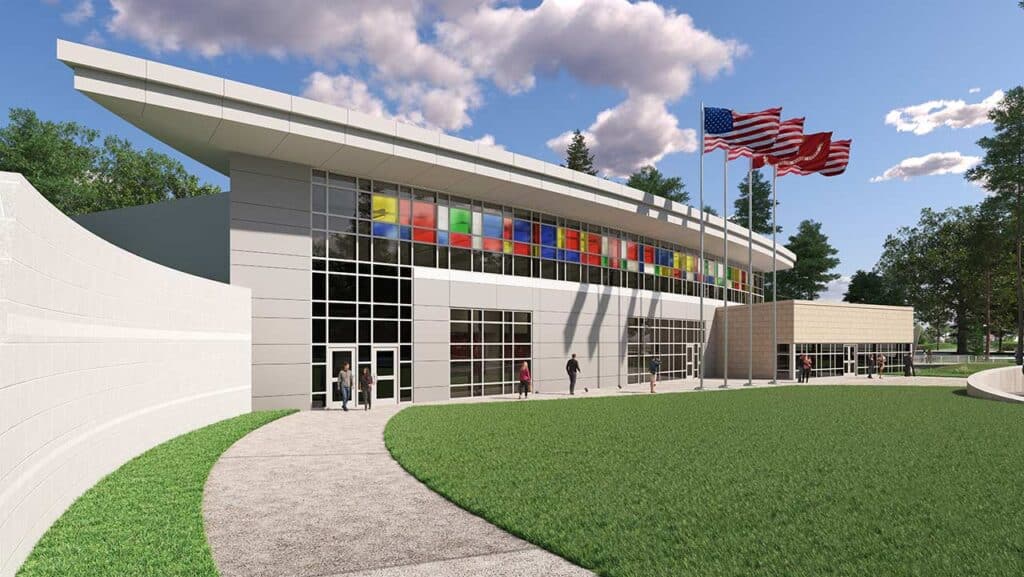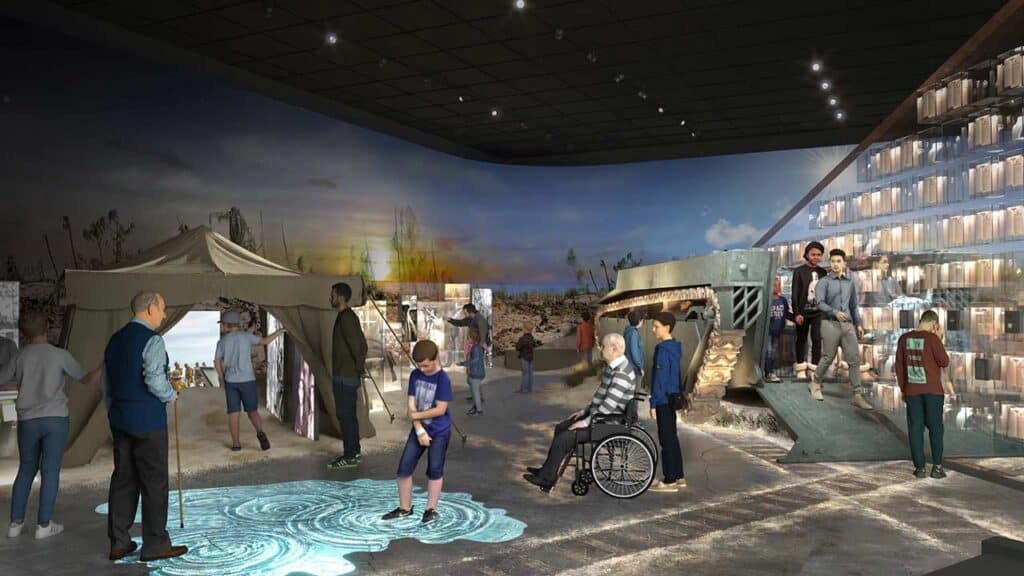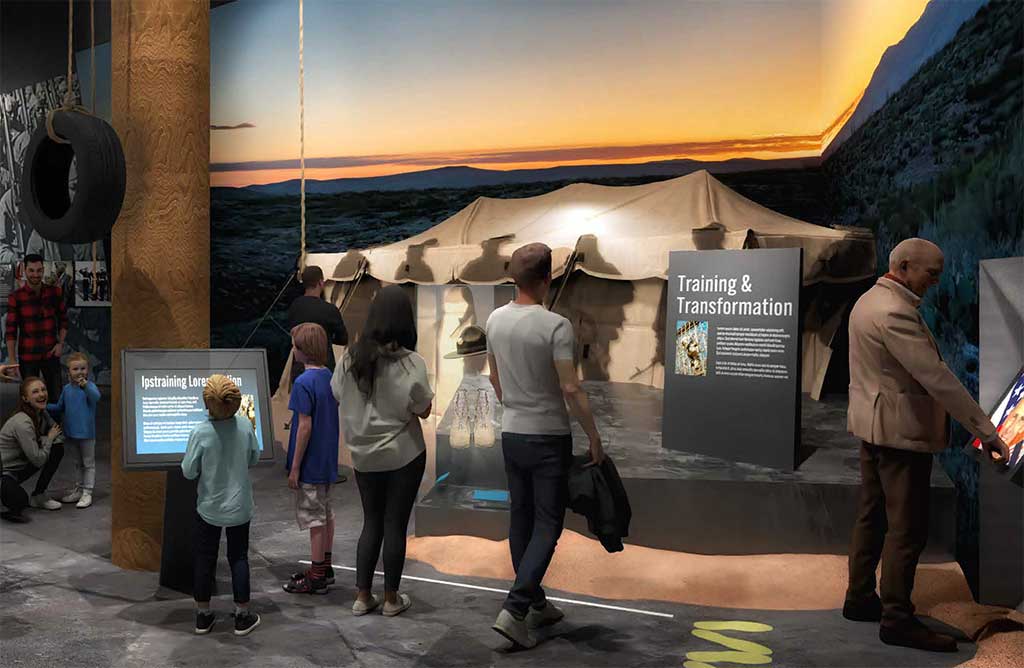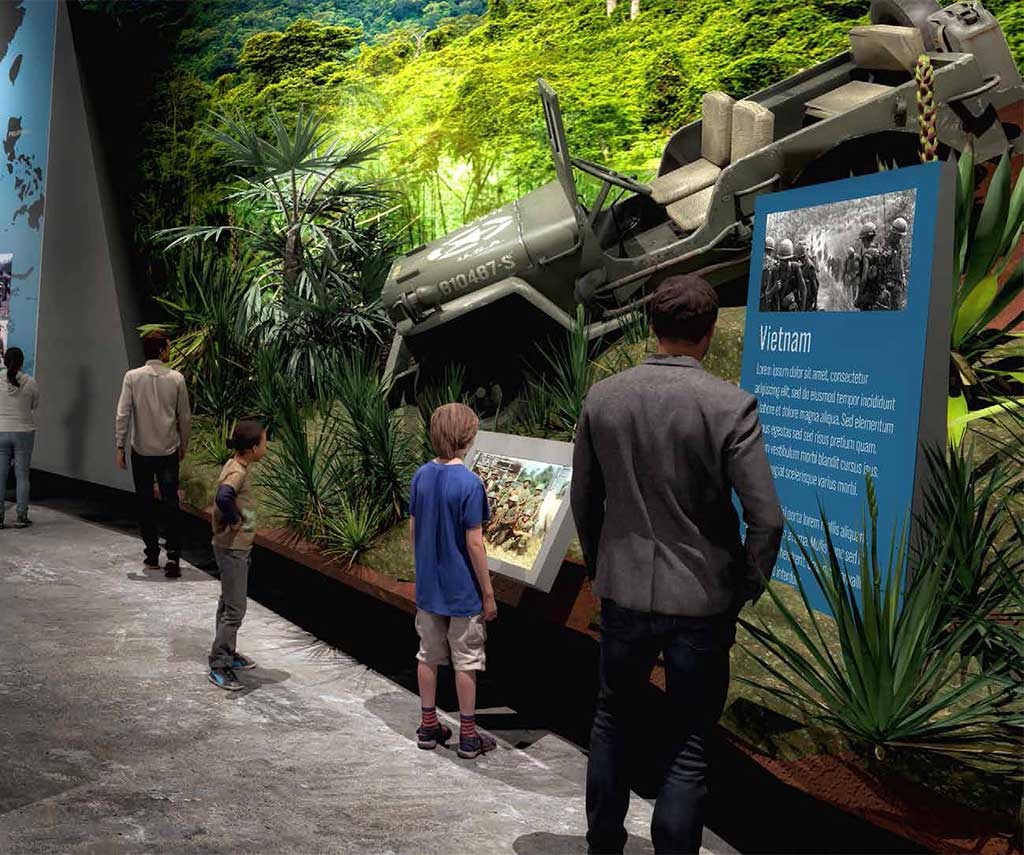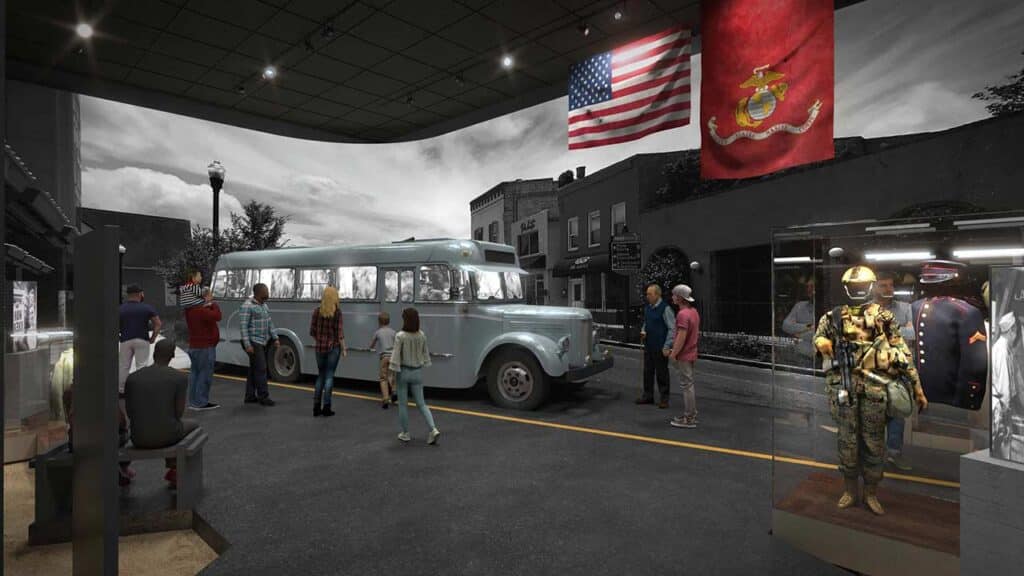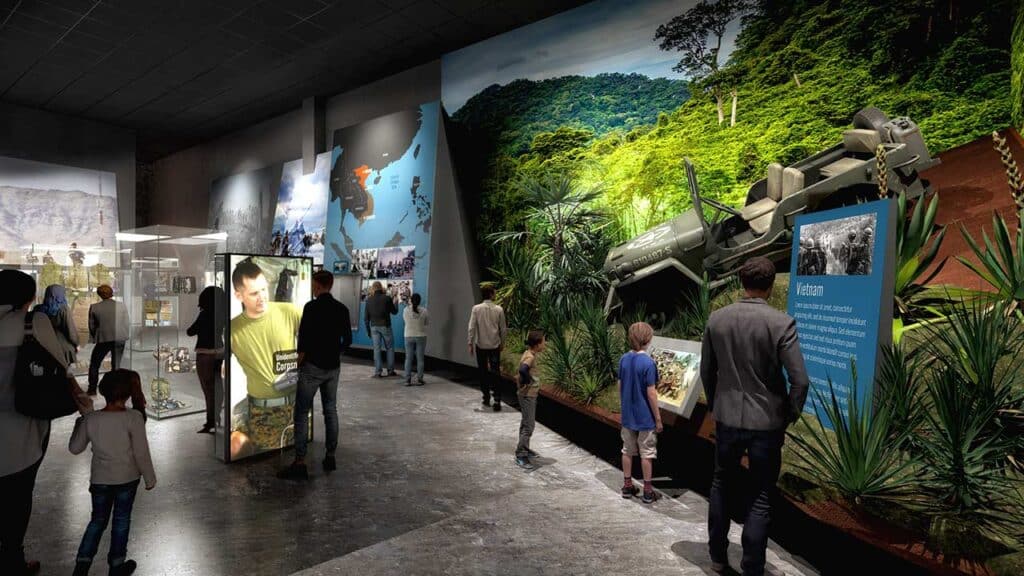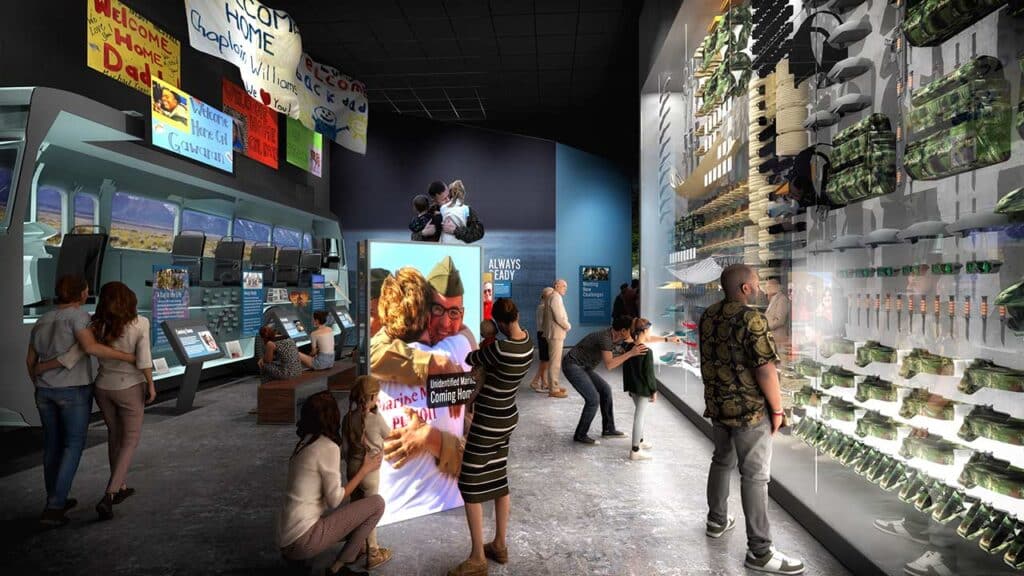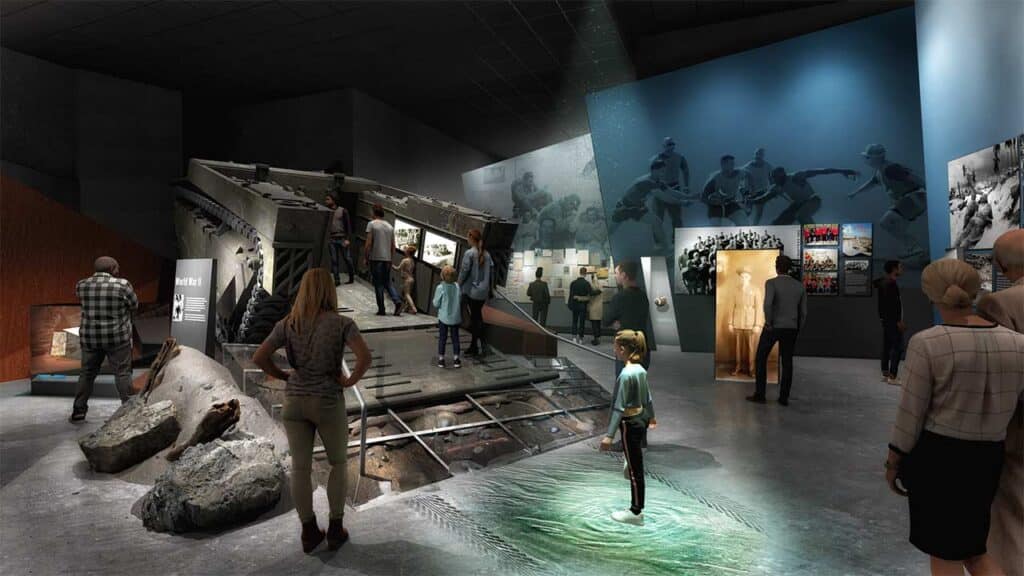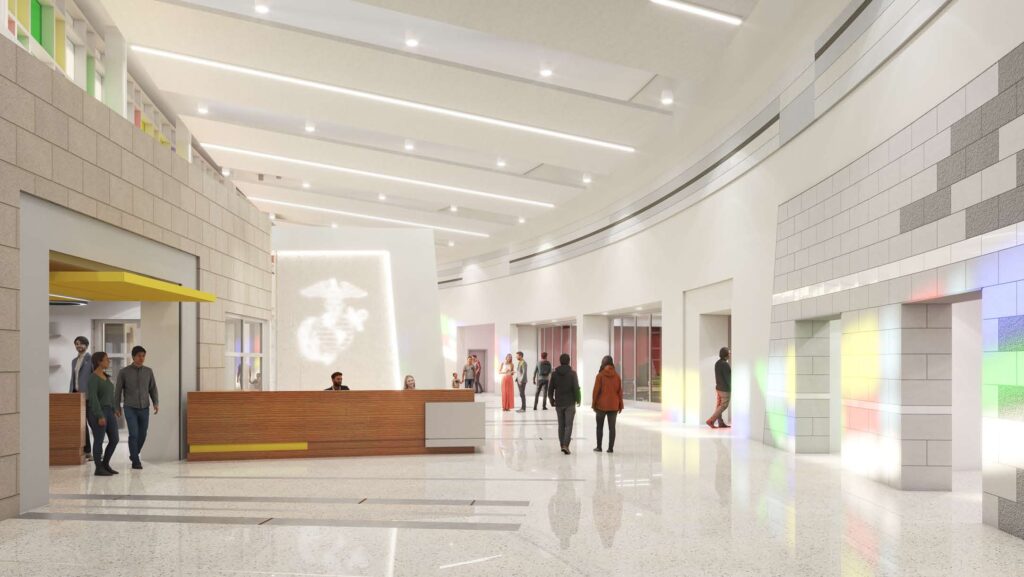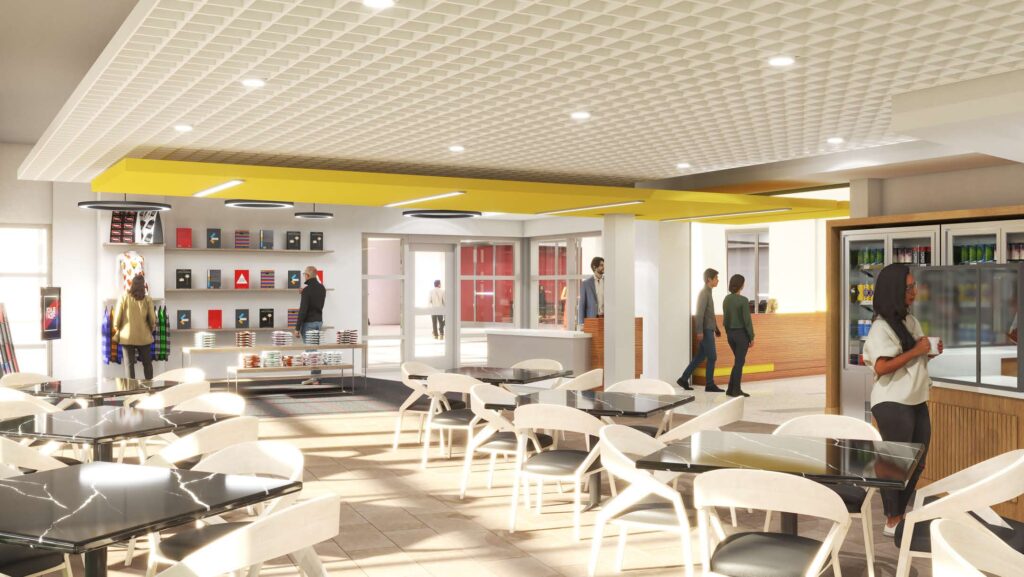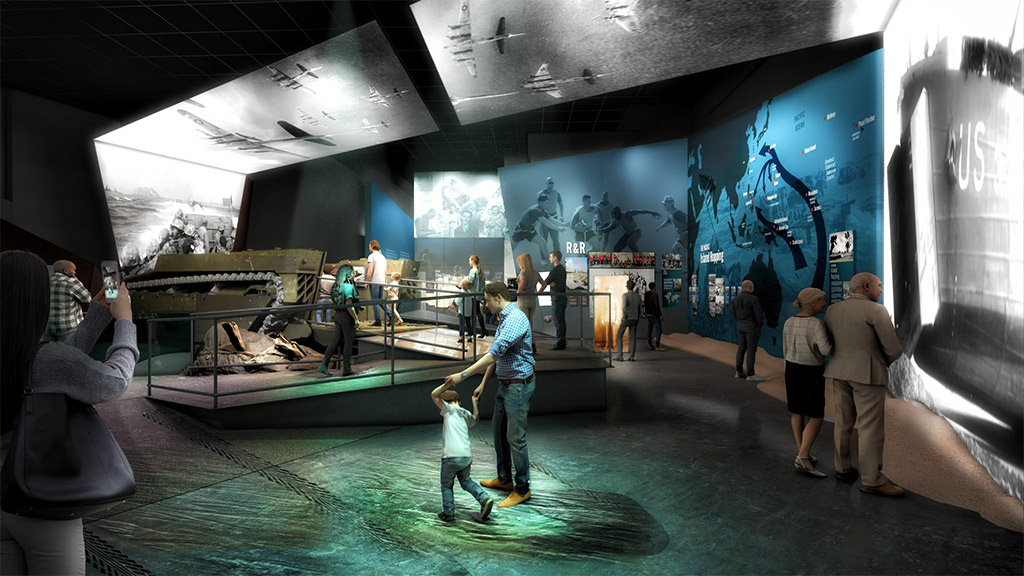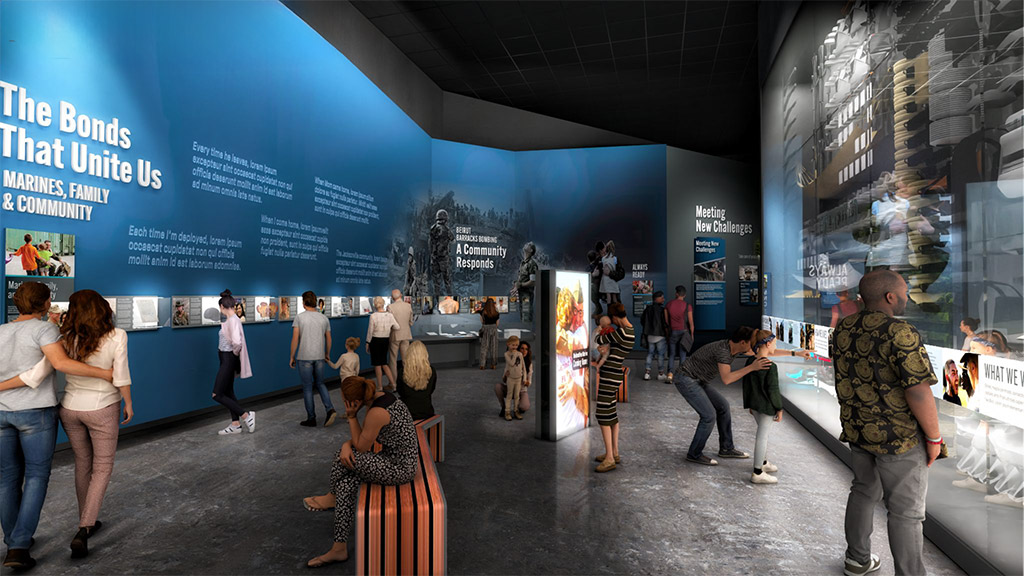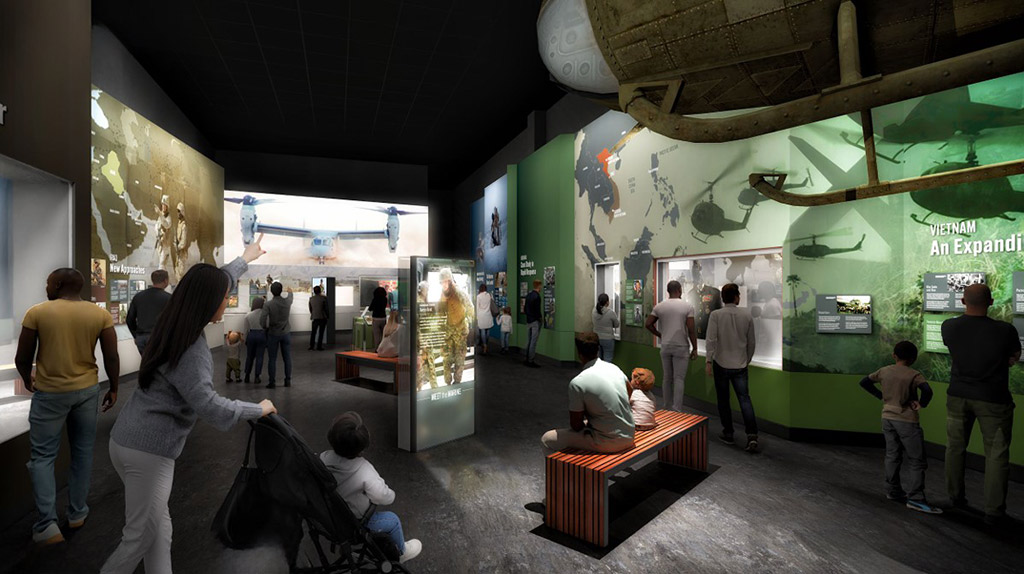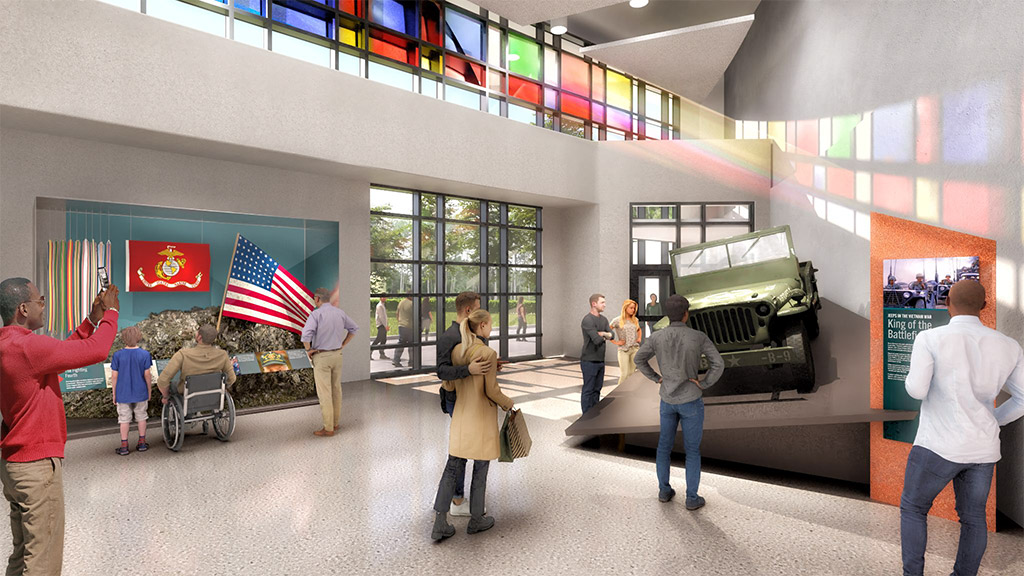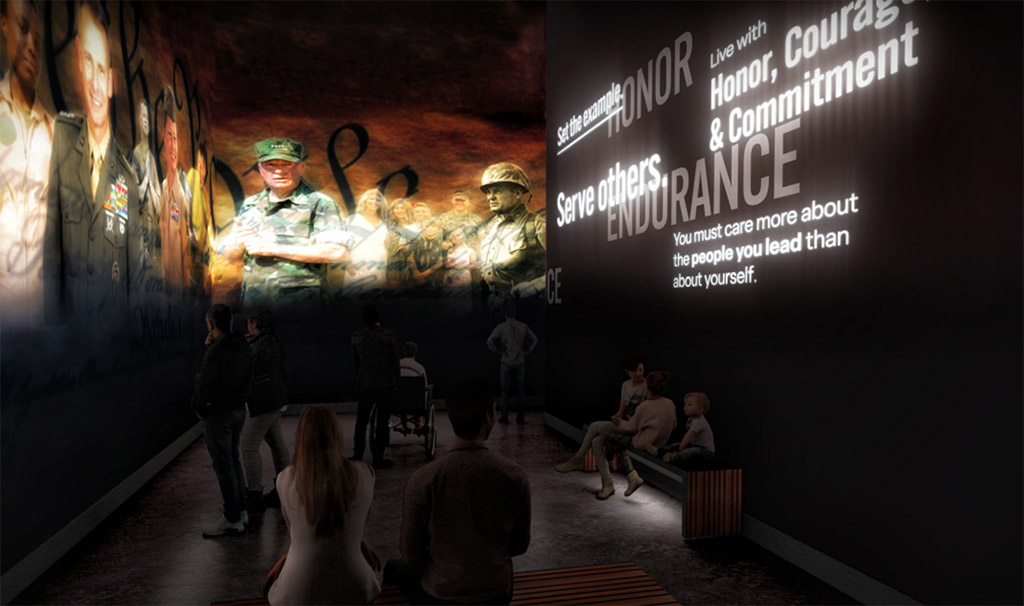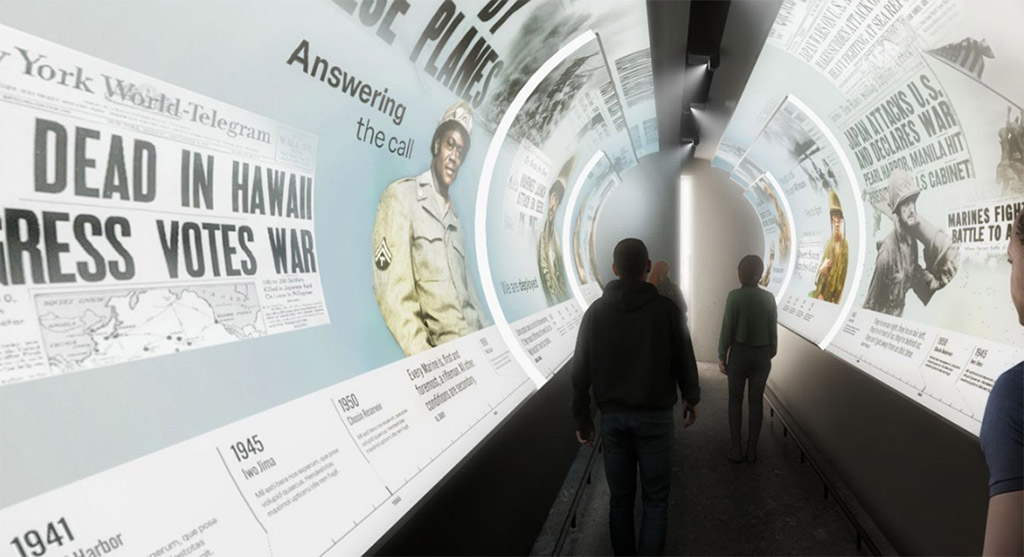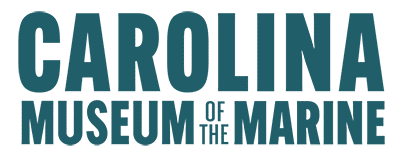Museum Galleries
Meet the Marine. Be inspired.
Welcome to the Image Gallery of the Carolina Museum of the Marine, where you can explore captivating architectural renderings showcasing the future interior and exterior of our museum facilities.
Designed to honor the legacy of Carolina Marines and Sailors, these images provide a glimpse into the inspiring vision of our forthcoming museum. Scheduled for completion in January 2025, with a groundbreaking event set for May 17, 2024 at 8:30 AM, join us on this exciting journey as we bring our vision to life. Immerse yourself in the artistic representation of our state-of-the-art exhibits, galleries, and educational spaces, and envision the impact this museum will have on generations to come.
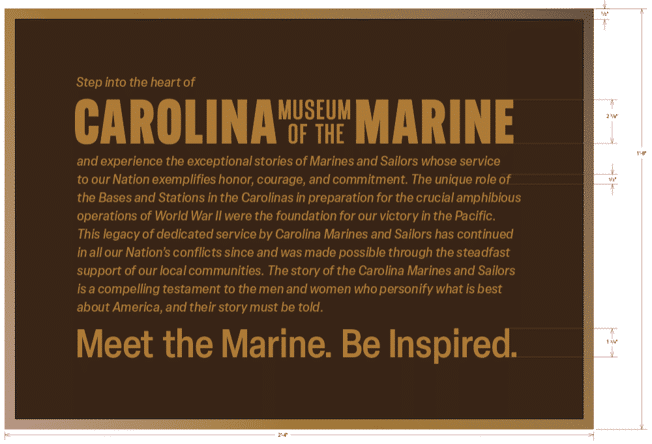
Upcoming Exhibits
The Great Hall
The great hall sets the tone for the museum experience. It is a space for gatherings, events, and programs. A central feature is a large display case housing a 48-star flag and battle colors carried by the historic 4th Marine Division in World War 2. Having cared for it for 70 years, they brought it home to pass on to the Marines of the II Marine Expeditionary Forces in an emotional Last Muster of the remaining World War II veterans in 2015 It is the iconic symbol of the museum’s collection of the values of service, sacrifice, and honor with the story it portrays other icons are prominent in the Great Hall:
“Where are They Now?” media globe which shows the global reach of Marines and the range of their service, operations, campaigns, and presence in defending and protecting our nation. The program covers different time periods and is updatable to include contemporary information.
An iconic Vietnam-era Jeep is an opportunity to connect to the storytelling within the museum and a great photo opportunity for visitors.
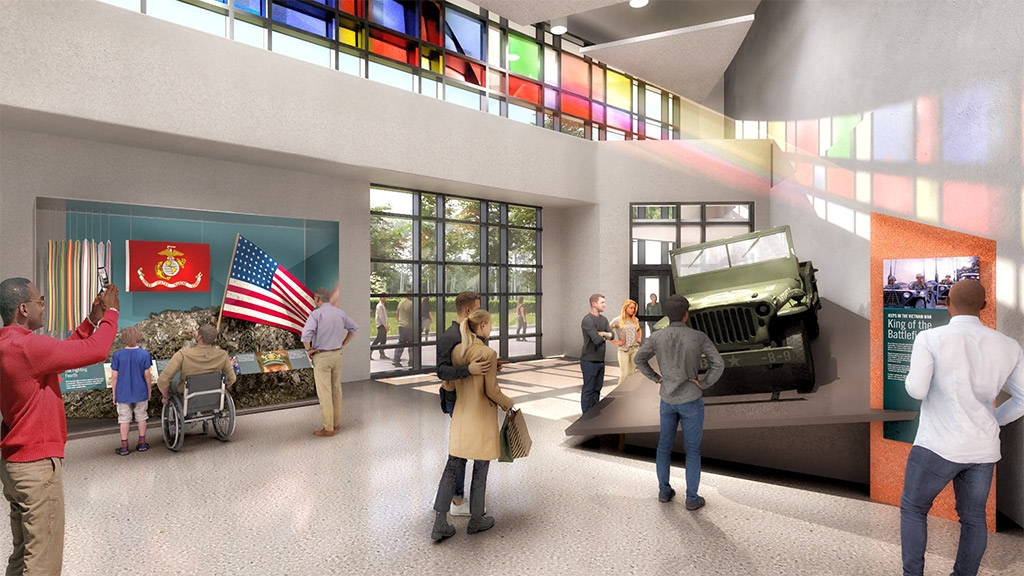
World Warriors
The role of Marine Corps Base Camp Lejeune in WWII Visitors will enter into a dynamic tunnel-like space surrounded by media projections or graphics, of images of the sea that will echo themes in the exhibit gallery to follow – “Meeting Marines” and “Answering the Call.” These are supported by a progression of headlines ranging from the attack at Pearl Harbor, entry into the Korean War, Vietnam, and 9/11 combined with images of Marines.
Quotes and words accompany the imagery conveying that Marines are there as our first responders, ready to deploy, ready to protect and defend. The band below forms a timeline of response to the call throughout Marine Corps history. The light emanating from the end of the entry gallery signifies that Marines are the “light at the end of the tunnel” and are always there for us, past and present.
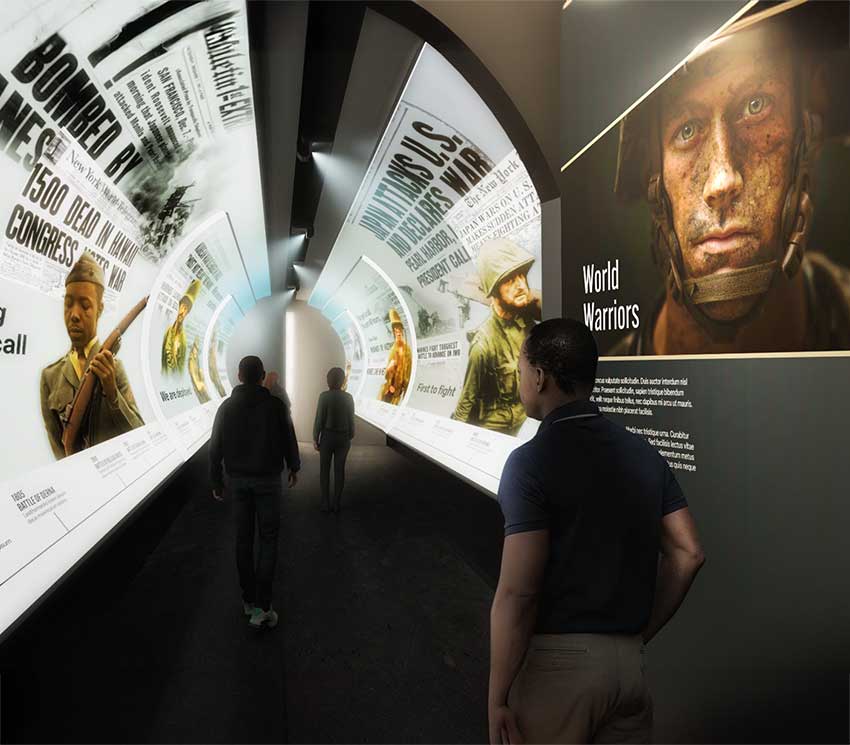
Gallery 1 – Marines Come From the Sea
Gallery 1 establishes a narrative journey that is rooted in a singular sense of place – the Carolinas – exploring the origins of the idea that Marines “come from the sea” and how that impacted their pivotal role in the Pacific during WW2. Here the themes of the core exhibition are presented in a way that makes this museum distinct. They are threaded through the stories of the original landowners, why the Marines came to this place and established Camp Lejeune, Parris Island, and Montford Point, the training and transformation that makes Marines, and how the innovation of amphibious warfare developed here met the challenges faced in the Pacific theater in WW2 and beyond.
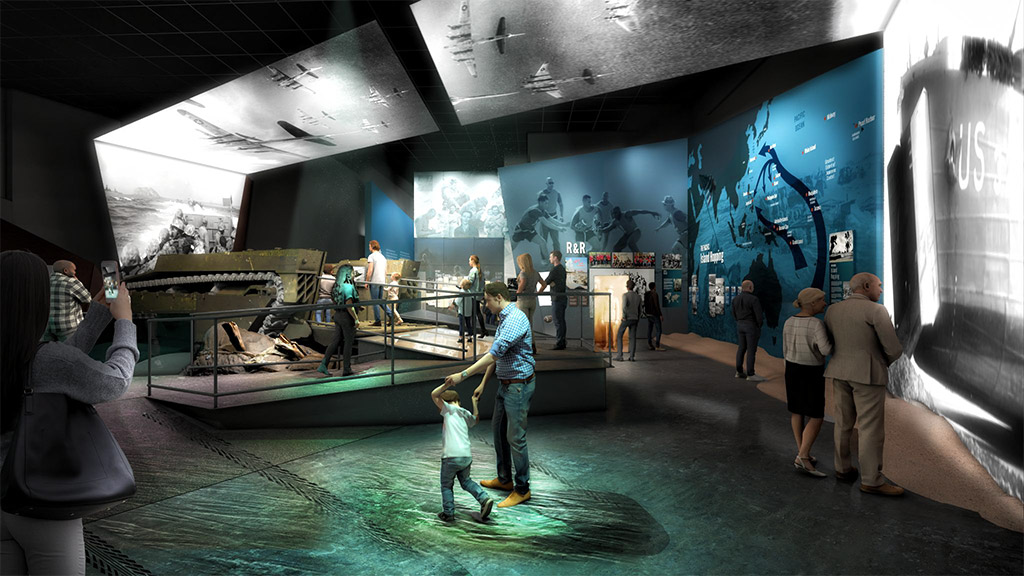
Gallery 2 – Coming Home
Gallery 2 is a reflective and deeply personal moment in the visitor journey where the experiences of Marines and their families are placed front and center. This gallery focuses on the duality of the Carolina Marine community, both as a home and as a place of duty. A large “Day in the Life” display case features items that Marines wore, carried, and how they lived. The opposite-facing gallery wall features personal stories of the community, families, and veterans who continued to serve others. These stories include a firefighter, a teacher, a civil servant, a federal official, a local community award, the USO, and a military child.
This gallery closes with the powerful story of selfless service and sacrifice following the 1983 Beirut bombing. The “No Greater Love” exhibit features some of the last letters home and artifacts of the Marines who “came in peace.” The exhibit highlights the inseparable bond between the Marines and the community where they serve, as a Nation came together, responded, and grieved.
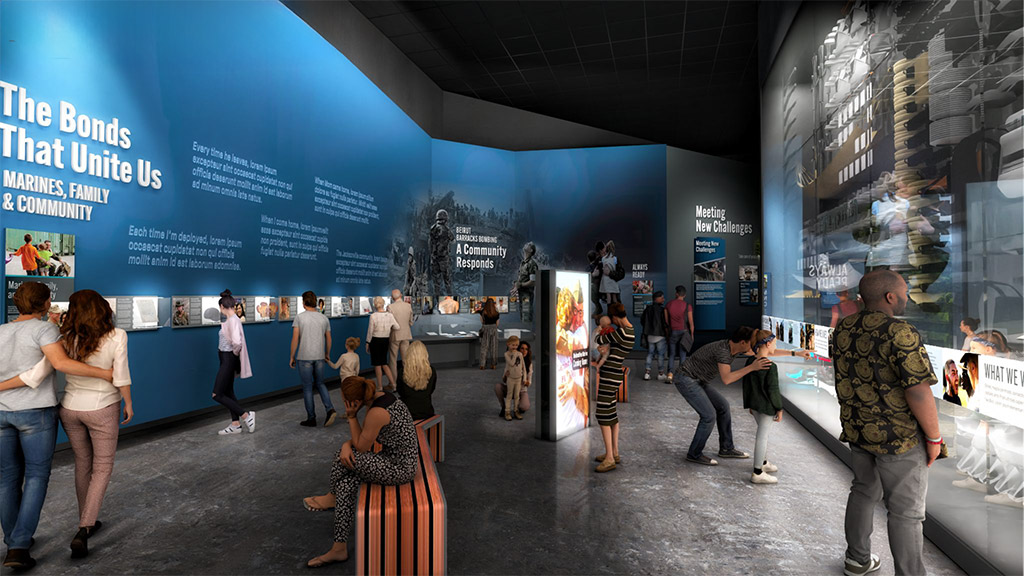
Gallery 3 – Meeting New Challenges
Gallery 3 highlights the many ways that Carolina Marines continue to be at the forefront of our Nation’s defense and adapt to meet new challenges. The gallery is a large zone: The Cold War, Missions Other than War, and the Global War on Terror.
While Marines and the Corps are timeless, they are also constantly adapting through training, warfare strategies, and technological innovations. Lessons learned, preparedness, “making thinking warriors,” and the significance of maneuver warfare will be themes of the gallery. Aviation innovation is a main feature from a Vietnam-era Huey helicopter to the introduction of the world’s first Tiltrotor military aircraft that will be exhibited in physical and media displays
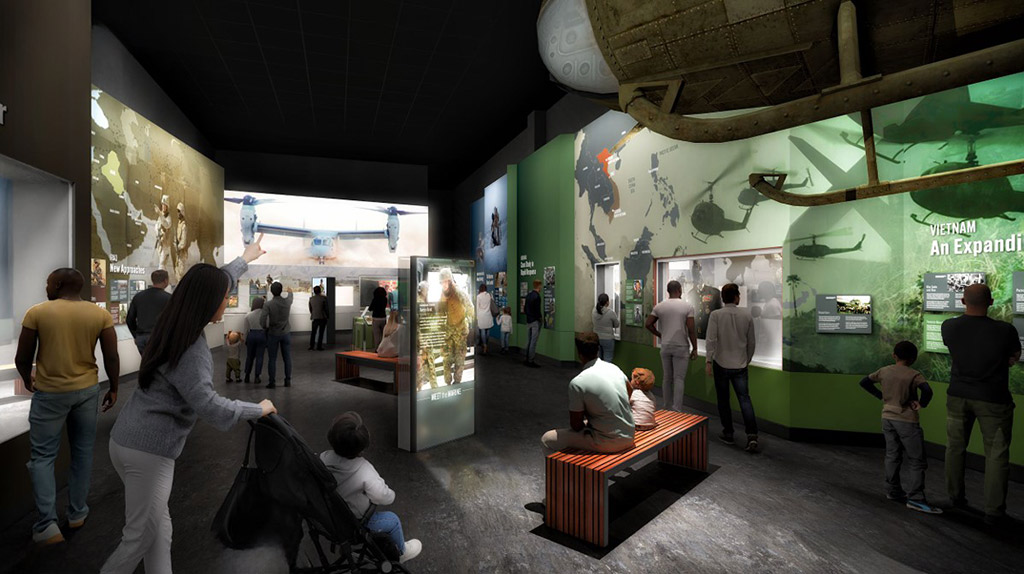
Outro – Always Faithful
The final exhibit zone highlights the core theme and mission of the museum – the role of values and service in each of our lives and what we can learn from Marines,
Visitors enter an immersive media experience that connects the themes and threads of the museum journey into a culmination of the core ideals of the museum – Marine values, leadership traits, and principles. Here these values are demonstrated through what Marines and others are doing today in their communities to serve as inspiration for what all of us can do to take actions, large and small, to be better and more engaged in our daily lives.
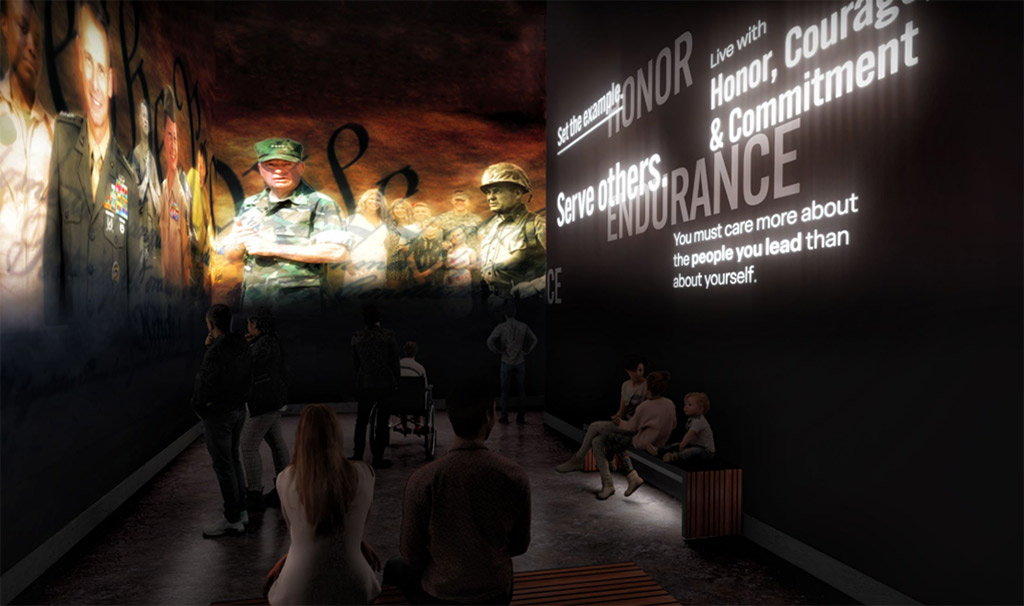
World Warriors
The role of Marine Corps Base Camp Lejeune in WWII Visitors will enter into a dynamic tunnel-like space surrounded by media projections or graphics, of images of the sea that will echo themes in the exhibit gallery to follow – “Meeting Marines” and “Answering the Call.” These are supported by a progression of headlines ranging from the attack at Pearl Harbor, entry into the Korean War, Vietnam, and 9/11 combined with images of Marines.
Quotes and words accompany the imagery conveying that Marines are there as our first responders, ready to deploy, ready to protect and defend. A band below forms a timeline of response to the call throughout Marine Corps history. Light emanating from the end of the entry gallery signifies that Marines are the “light at the end of the tunnel” and always there for us past and present.
Meet the Marine
The Meet the Marine experience is introduced in Gallery 1 and continues throughout each of the subsequent galleries, culminating in the last Always Faithful gallery. This recurring element gives visitors the opportunity to interact with the stories of remarkable Marines, past and present. Each station introduces an individual Marine and a graphic or media experience helps the visitor to learn about their service. Assets may vary depending on the time period from which the Marine comes, but may include images, video interviews, or audio recordings. Meet the Marine” stations may feature one individual, with a potential media depiction on one side of the plinth and graphics and/or artifactson the other side to support their story. Other stations may include a pairing of individuals, with interpretation on each side of the plinth. All “Meet the Marine” stations are connected to a particular theme or event within a gallery, and all give voice not just to one event or experience, but to the overarching Marine values, traits, and ethos.
Marines Come from the Sea
Gallery 1 establishes a narrative journey that is rooted in a singular sense of place – the Carolinas – exploring the origins of the idea that Marines “come from the sea” and how that impacted their pivotal role in the Pacific during WW2. Here the core themes of the core exhibition are presented in a way that makes this museum distinct. They are threaded through the stories of the original landowners, why the Marines came to this place and established Camp Lejeune, Parris Island, and Montford Point, the training and transformation that makes Marines, and how the innovation of amphibious warfare developed here met the challenges faced in the Pacific theater in WW2 and beyond.
A set of concepts guide the storytelling in the exhibits in each gallery of the museum:
- How Marines met new challenges in the past, and the ways in which they will continue to do so now and in the future, always ready to answer any call
- That innovation and adaptability has taken many forms, from technological advances to warfighting strategies to new ways of thinking and problem solving, including learning from successes and failures
- The values and principles that are part of the culture and ethos of Marines (“we not me”) will be demonstrated by the many personal stories elevated and featured prominently throughout
- Ensuring that the connection to the Carolinas, Camp Lejeune and Jacksonville will be forefronted wherever possible
The Place and the People
As visitors emerge from the World Warriors experience into Gallery 1, they have an expansive view of the first half of the gallery and an introduction into the fundamental concept that “Marines come from the sea.” The first two exhibits focus on location – the Carolinas, Onslow Beach, Camp Lejeune, Parris Island and Jacksonville – rooting visitors in the “why here” storyline that will thread throughout the entire exhibition. The story of how Camp Lejeune was established as a place for Marines to train specifically in amphibious warfare unfolds in tandem with the story of the original landowners whose contributions in giving up their homes played a pivotal role in the larger story of service and sacrifice in WW2. This begins the important theme of the connection between the Marines and the community of Jacksonville which visitors will encounter at various points in each gallery. Visitors will also see the first “Meet the Marine” station highlighting the story of Lt. Gen John Lejeune.
Training and Transformation
As visitors emerge from the World Warriors experience into Gallery 1, they have an expansive view of the first half of the gallery and an introduction into the fundamental concept that “Marines come from the sea.” The first two exhibits focus on location – the Carolinas, Onslow Beach, Camp Lejeune, Parris Island and Jacksonville – rooting visitors in the “why here” storyline that will thread throughout the entire exhibition. The story of how Camp Lejeune was established as a place for Marines to train specifically in amphibious warfare unfolds in tandem with the story of the original landowners whose contributions in giving up their homes played a pivotal role in the larger story of service and sacrifice in WW2. This begins the important theme of the connection between the Marines and the community of Jacksonville which visitors will encounter at various points in each gallery. Visitors will also see the first “Meet the Marine” station highlighting the story of Lt. Gen. John Lejeune.
Becoming a Marine
Parris Island – Iconic yellow footprints and a drill sergeant’s hat are emblems of what the new recruits will encounter as they begin the mental and physical process of training and transformation. A short film gives visitors an overview of what training is like for Marine recruits at Parris Island and includes personal reflection from Marines who have experienced this transformation. From the “shock and awe” of the arrival, through the stages of basic training and into Warrior Week, the film speaks to the idea that individuals are coming from different backgrounds and family contexts and that they are now becoming part of a group. The film ends with graduation and the emblem ceremony at which recruits earn the title “Marine.”
Making a Marine – “From this day on they will be known as Marines.” – from Graduation and Emblem Ceremony
Here visitors move from the physical aspects of training to the less tangible values of how the ethos, culture, and codes of becoming a Marine are instilled during the training process. Images convey the formation of a group, to the moving from training gear to dress blues. The graduation and emblem ceremony is highlighted against the backdrop of the type of learning that goes into becoming a Marine – Al Gray’s reading list, history, and understanding the principles of the expeditionary mindset – the distinctive aspects of Marine Corps training beyond the physical challenges. First person quotes and stories reflect the pride of becoming a Marine and the journey it took to get there.
This exhibit will also prominently feature the extensive and expansive types of contemporary training that Marines do to prepare to meet new challenges. Beyond boot camp, it shows the myriad ways that Marines develop expertise to operate in diverse climates and terrains, master the technological skills of communications and equipment, and organize effectively in all of the support positions.
From the Sea
In a mini-theater located between Training and Transformation and the WW2 portion of the gallery is a film that gives an overview of how the training in Camp Lejeune prepared Marines for battles in the Pacific, and how the innovative development of amphibious operations and technology led to those successes. The museum’s gator flag is displayed on the introductory wall making the symbolic connection between the Carolinas and the LVT.
They Answered the Call
The stories of the first African-American recruits that trained at Montford Point in 1942 and their role in WW2 are told here in first- person accounts, historic imagery and footage, and artifacts. Their service, the challenges they met, and their ongoing legacy are depicted, as is their heroism in WW2. Here visitors “Meet the Marine” Sgt. Major Edgar Huff who was one of the original Montford Point Marines and went on to serve in two tours of duty in Vietnam. The first women Marines that comprised the Women’s Marine Reserves at Camp Lejeune is the last exhibit in the Training and Transformation zone. Personal stories and artifacts from the museum’s collection speak to the spirit of these women, from their arrival at Camp Lejeune, what life was like for them at that time, and their important role in aviation training. Their stories, like those of the Montford Point Marines are important and often untold in the history and ongoing development of the Marine Corps.
Guadalcanal
Carolina Marines First – In August, 1942 Marines landed on the beaches of Guadalcanal. This landing marked the first Allied offensive in the Pacific and the first amphibious assaults against the enemy. The capture of Guadalcanal marked the turning point for the war in the Pacific and it also tested out the LVT. A specially lighted artifact case embedded in the exhibit wall showcases one of the museum’s highlight objects – a bracelet made by a Marine with a k-bar knife and a ration food can. He inscribed the bracelet with his
Marine and family memories and wore it through his campaign. Visitors will encounter these special “jewel” object cases accompanied by personal stories as highlight moments throughout all the exhibits.
The LVT and WW2 Exhibit Zone
The gallery is designed to position the LVT as a “reveal” moment in the visitor experience, elevating the power of this large- scale artifact to create a memorable “wow” moment for visitors, and to make them more connected to the real experiences of Marines. A ramp leads visitors up into the LVT where they will feel what it is like to be inside. The addition of a media and graphic wrap enveloping the vehicle creates an immersive, emotional factor, providing views of footage and powerful imagery of Marines onboard, their viewpoint out to sea and towards land, Navy ships, and landings. Images above the LVT show aircraft in the skies – reiterating the “land, sea, air” theme. The entire experience ties the LVT to the Guadalcanal and Island Hopping stories “bridging” the content and themes.
Island Hopping
The battles and campaigns that were part of the island- hopping strategy in the Pacific are depicted in a large-scale map and series of exhibits highlighting personal accounts and artifacts from the museum’s WW2 collection. The immense challenges that faced Marines in the Pacific — from Pelieu to Iwo Jima — are described within the context of the impact that Marines made to winning that war.
Letters Home
A transition from the first gallery into the next is a moving display of letters home from Marines to family and friends and letters they received in Return. It illustrates the importance of contact with home and family as a powerful and sustaining aspect of the war experience.
Coming Home – Gallery 2
is designed to provide a reflective deeply personal moment in the visitor journey where the experiences of Marines and their families are placed front and center. This gallery explores the many ways in which generations of Marines and their families, have “answered the call.” An important feature of this gallery is to focus on the significance of the Jacksonville community and how Camp Lejeune and the Marines are an integral part of that.
Gallery 2 – Day in the Life: Marines
On one side of the gallery, a large artifact case offers insight into the daily life of Marines on deployment leveraging the museum’s extensive collection. Spanning the width of the case at visitors’ eye level, “Personal Collections Features” showcase uniforms and objects that have been donated to the museum in honor of specific individuals. The rest of the case is organized by three overarching themes of “What We Wore,” “How We Lived,” and “What We Carried,” illustrating the continuum of the Marine experience by way of items both specific to individual experience of service and also universally recognizable to those who have also served.
Gallery 2 – The Bonds That Unite Us: Marines, Family, Community
This large exhibit wall features an array of personal stories and small artifact cases that speak to the many ways Marines, their families, and members of the community intersect, impact and support each other over time. First person narratives and short quotes will be simple, clear and relatable. Stories and connections may include the experience of a WW2 Marine coming home, that of a Marine from Afghanistan, a spouse of a recently deployed Marine, a Vietnam vet who helped build the community, and a Jacksonville business owner, among others. The last personal story will be of a Marine from the Beirut mission era who was at Camp Lejeune, providing a transition to the next exhibit.
Beirut Barracks Bombing – A Community Responds
The 1983 Beirut bombing devastated the nation, Camp Lejeune, and the Jacksonville community. A powerful story of selfless service and sacrifice, it conveys how a community’s outpouring of support in response to tragedy illustrates the interconnection between the Marine and civilian experience. This exhibit features the last letters sent home before the attack on the Marines who “came in peace,” and is part of the “No Greater Love” project. An interactive featuring excerpts from these letters may also include the message delivered by General Al Gray immediately after the attack expressing support to Marines at Camp Lejeune, their families, and those in the community. A wooden box with the words “Semper Fi” carved on it is featured along with the story of the wounded Marine who made it.
Gallery 3 – Meeting New Challenges | Making Thinking Warriors
A signature feature of this gallery is the Osprey display as a core example of innovation that will visually signify to visitors the “Air” theme that is part of the museum’s overall narrative. The goal is to make design and interpretive connections between the use of helicopters from Korea onwards to the Ospreys. Innovation and adaptability stations will also highlight technological advances in equipment, communications, and medical care. The concept of innovation also applies to innovations in thinking and doctrine – “making thinking warriors” and the “expeditionary mindset.” Three zones frame the gallery: The Cold War, The Global War on Terror, and Always Serving. Within these zones the main exhibits of specific wars and missions will be featured (e.g. Korea, Vietnam, Desert Storm, etc.). Always Serving is located at the end of the gallery and focuses on the important role Marines have played in humanitarian efforts, whether on specific missions or in combat areas. This outreach and humanitarian work continues for Marines after they leave service and this provides a meaningful transition into the last gallery space.
Highlighting the importance of innovations and adaptability and framing each war and mission into a more specific aspect of how Marines meet new challenges is a way for us to select stories and content that reflect core ideas while still ensuring that we have a way for a “deeper dive” into the subject matter for those interested. We want to convey that while Marines and the Corps are timeless, they are also constantly adapting whether through training, warfare strategies, or innovations. The throughline of lessons learned, preparedness, and “making thinking warriors” will be highlighted, as will the role of Camp Lejeune and the Carolinas in these missions.
Meet the Marine – General Al Gray
As part of the transition into this gallery visitors meet General Al Gray via a Meet the Marine station. Gray’s quote, “War is both timeless and ever changing” frames one of the key themes of this gallery — how Marines continue to meet new challenges, and how the Marine Corps evolves and reforms with new thinking and practices. Here Gray provides context and background for these developments post WW2 and into more recent times. “. . .like war itself, our approach to warfighting must evolve.” General Al Gray Gallery 3 weaves the history, ethos and innovations of Marines from the Cold War, Korea, Vietnam, and Grenada to Afghanistan, the Global War on Terrorism, Desert Storm, and Iraq.
MAGTF – Always Serving, Always Faithful
The final exhibit zone highlights the core theme and mission of the museum – the role of values and service in all of our lives and what we can learn from Marines. Visitors enter an immersive media experience that connects all of the themes and threads of the museum journey into a culmination of the core ideas of the museum – Marine values, leadership traits and principles. Here these values are demonstrated through what the Marines and others are doing today in their communities to serve as inspiration for what all of us can do to take actions, large and small, to be better and more engaged in our daily lives.


